Respirator Fact Sheet
What You Should Know in Deciding Whether to Buy Escape Hoods, Gas Masks, or Other Respirators for Preparedness at Home and Work
Some employers and consumers are considering purchasing escape hoods or other respirators to protect themselves against potential terrorist threats, including biological and chemical substances. This guidance will provide information on what respirators are, how they work, and what is needed for a respirator to provide protection.
Is buying an escape hood or other type of respirator the best way to protect myself, my family, and/or my employees?
If available and used correctly, a respirator can selectively reduce the exposure you might otherwise receive. Respirators have been used for many years in the workplace, where employers have programs to make sure the proper masks are selected and that the respirator fits. When consumers use respirators, they don’t have such support, so this fact sheet includes lots of background information to help consumers understand the limitations and cautions that need to be considered. The goal is to avoid unintended problems that might occur through lack of understanding or a false sense of security.
As a first step, plan how to respond if an emergency happens. A respirator is only one small part of that plan. There may be situations in which it’s simply best to stay where you are and avoid any uncertainty outside, a process known as “shelter-in-place,” as a means of survival. Use available information to assess the situation. If you see large amounts of debris in the air, or if local authorities say the air is badly contaminated, you may want to take this kind of action. The US Department of Homeland Security offers information on shelter-in-place and other emergency planning recommendations on its Internet site, and through a toll-free number, 1-800-BE-READY.
Respiratory protection is effective only if:
- the correct respirator is used,
- it’s available when you need it,
- you know when and how to put it on and take it off, and
- you have stored it and kept it in working order in accordance with the manufacturer’s instructions
Each type of respirator can come in several varieties, each with its own set of cautions, limitations, and restrictions of use. Some respirators require testing to ensure a tight fit to the face, and should not be used with facial hair. Others use a nose clip and mouthpiece, which is clenched between your teeth, similar to a snorkel. Some respirators prevent the user from talking while others have speaking capabilities. Every respirator contaminated with hazardous chemicals should be decontaminated and disposed of properly.
All respirators require training to be properly used. Sometimes you can practice using your own respirator. Some escape respirators come in a package that must remain sealed until use, so you need to be trained using a special “practice” version. Training is extremely important in regard to the storage, maintenance, use, and discarding of the respirator. This information is provided by the supplier of the respirator (i.e. seller, distributor, or manufacturer).
If you do not use a respirator correctly, it is very likely that it will not protect you-and may even hurt you. The following information will help you understand what a respirator is, and how it should be used.
What is a respirator?
A respirator is a device to protect you from inhaling dangerous substances, such as chemicals and infectious particles. There are several different types of respirators, as described below.
EscapeRespirators
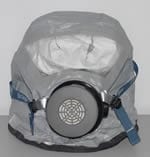
Escape respirators are designed to be used only in an emergency, and only to escape from a dangerous area to a safe area. There are several escape respirators on the market. Many of them use a hood with a neck seal instead of a facepiece. They are typically designed for one-time use for a short period, typically 15 minutes to 1 hour. They may be available in a variety of sizes and will fit most adults. Individuals with small or very large neck sizes may not be able to use some escape hood designs-check the supplier product information before purchasing.
Particulate Respirators
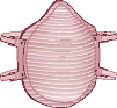
Particulate respirators are the simplest, least expensive, and least protective of the respirator types available. These respirators only protect against particles. They do not protect against chemicals, gases, or vapors, and are intended only for low hazard levels. The commonly known “N-95” filtering facepiece respirator is one type of particulate respirator, often used in hospital to protect against infectious agents. Particulate respirators are “air-purifying respirators” because they clean particles out of the air as you breathe. Even if you can’t see the particles, there may be too many in the air for this respirator to provide adequate protection.
Chemical Cartridge/Gas Mask Respirator
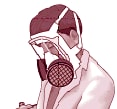
Gas masks are also known as “air-purifying respirators” because they filter or clean chemical gases and possibly particles out of the air as you breathe. This respirator includes a facepiece or mask, and a filter/cartridge (if the filter is in a metal shell it is called a “canister”). Straps secure the facepiece to the head. The cartridge may have a filter to remove particles (such as a biological weapon), charcoal (to remove certain chemicals), both, or other parts. When the user inhales, air is pulled through the filter.
Gas Masks are effective only if used with the correct cartridge or filter (these terms are often used interchangeably) for a particular biological or chemical substance. Selecting the proper filter can be a complicated process. There are cartridges available that protect against more than one hazard, but there is no “all-in-one” filter that protects against all substances. You need to know what hazards you will face in order to be certain you are choosing the right filters.
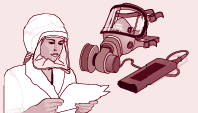
Powered Air-Purifying Respirator (PAPR)
Powered air-purifying respirators use a fan to blow air through the filter to the user. They are easier to breathe through and they need a fully charged battery to work properly. They use the same filters as gas masks, so you need to know what the hazard is, and how much of it is in the air.
Self-Contained Breathing Apparatus (SCBA)
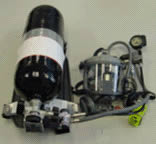
Self-Contained Breathing Apparatus (SCBA) is the respirator commonly used by firefighters. These use their own air tank to supply clean air, so you don’t need to worry about filters. They also protect against higher concentrations of dangerous chemicals. However, they are very heavy (30 pounds or more), and require very special training to use and to maintain them. Also, the air tanks typically last an hour or less depending upon their rating and how hard you are breathing.
The following questions and answers provide additional information for use in selecting and using gas mask and escape respirators.
At the end of this Fact Sheet, you will find a list of questions you should ask before purchasing a Gas Mask or Escape Respirator.
Can I buy any Gas Mask or Escape Respirator and expect it to protect me from anything that might happen?
These respirators must be selected for protection against a specific hazard.
The cautions, limitations and restriction of use provided with the respirator must be strictly followed. If your mask does not make a tight seal all the way around your face when you inhale, you may breathe contaminated air that leaks around the edges of the face seal. Anything that prevents the face mask from fitting tightly against your face, such as a beard or long sideburns, may cause leakage. Some respirators come in different styles and sizes, and fit different people differently because people’s faces have different shapes. You also need training to know how to correctly put the mask on and wear it correctly. This information should be provided by the supplier of the respirator.
If I have the right cartridges/filters for a certain hazard, and my mask fits, will they always protect me against that hazard?
Gas Masks and Escape Respirators reduce exposure to the hazard, but if the exposure is such that it goes beyond what the filter is capable of handling (either because the amount of toxic gas or particles is more than what the filter is designed to handle, or because the exposure lasts longer than what the filter is designed to handle), the filter may not be effective in providing required protection. Also, there may be a small amount of leakage even if the fit of the respirator has been tested. If so, and if there is large amount of a toxic chemical in the outside air, even that small leakage can be dangerous.
Can anyone wear a respirator mask?
Breathing through a respirator is harder than breathing in open air. People with lung diseases such as asthma or emphysema, elderly people, and others may have trouble breathing. Some people with claustrophobia may not be able to wear a mask or hooded respirator. Some people with vision problems may have trouble seeing while wearing a mask or hood (there are special masks for people who need glasses).
Will a gas mask protect children?
There are a variety of problems with fit and use of respirators for children, especially small children and infants. For example, currently available masks are unlikely to fit the faces of small children and infants. As with respirator use by anybody, fit-testing, training, and proper use and maintenance are essential.
Will my cartridge/filter and respirator mask protect forever?
Cartridges, filters, and masks get old. Cartridges can have a limited life. If the filter cartridges that attach to the mask are outdated, have been open to the air or are damaged, you are not protected. Cartridges that contain charcoal or other chemicals for filtering the air should be in air-tight packages. If cartridges are open or not packed in air-tight packaging, they should not be used. Even cartridges in original packaging have expiration dates that should be checked before purchase. Also, over time your mask can get old and break down. Keep your mask in a clean, dry place, away from extreme heat or cold. Inspect it according to the manufacturers instructions.
If I wear a Gas Mask correctly, am I completely safe?
The filter cartridges protect against only certain inhaled airborne substances. Some dangerous chemicals are absorbed through the skin. Properly selected and worn gas masks and escape respirators must be combined with protective clothing to completely prevent injury from these chemicals.
Will a Gas Mask protect me if there is not enough oxygen in the air?
Gas Masks do not provide oxygen. If used in an environment with low oxygen levels, such as a fire, you are in danger of suffocation.
Will a Gas Mask protect me if there is a fire?
It’s important to read the manufacturer’s information if your main concern is to be able to escape from a smoke-filled building. Smoke particles can rapidly clog gas mask filters, and filters with special chemicals are needed to protect against carbon monoxide and other gases that may occur in a fire. Not all gas masks and escape respirators protect against these hazards. Some components, including hoods and facepieces, of many of the gas masks and escape respirators may melt if exposed to a fire.
Once I put on my Gas Mask or Escape Respirator, how long will it last?
That depends on how much filtering capacity the respirator has and the amount of hazard in the air – the more chemical or biological hazard in the air (higher concentration), the shorter the time your filter will last. There is no absolute time limit, and it will vary by each respirator model’s capacities. That’s why your emergency plan must include some idea of how to get to a safe area before the filtering capabilities of the mask runs out.
How do I know a respirator will protect me against the hazards it claims to protect against?
No agency in the U.S. tests and certifies respirators for use by the general public, however, the National Institute for Occupational Safety and Health (NIOSH) part of the Centers for Disease Control and Prevention (CDC), tests and certifies respirators for use by workers to protect against workplace hazards. Respirators certified by NIOSH will say “NIOSH Approved” and may have a certification number. However, NIOSH only certifies respirators against specific hazards. Just because a respirator is certified does not mean it will protect against ALL hazards. NIOSH-certified respirators are supplied with Approval Labels that identify the hazards that the respirator is approved to protect against. If you are buying a respirator, you should check the Approval Label to be sure that it has been certified against the hazards you want protection against.
The Questions You Should Ask About Any Respirator You Are Considering Purchasing
- What protection (which chemicals and particles, and at what levels) does the escape hood provide?
- Is there more than one size?
- How do I know if the gas mask or escape hood will fit?
- What type of training do I need?
- Has the escape hood been tested against claims for protection such as biological agents, chemical warfare agents, toxic industrial chemicals, and radioactive dust particles?
- Who performed the testing, what were the tested levels, and test durations?
- Is the escape hood certified by an independent laboratory or government agency?
- Are there any special maintenance or storage conditions?
- Will I be able to talk while wearing the respirator?
- Does the hood restrict vision or head movement in any way?
- Can I carry the device in the trunk of my automobile?
- Is a training respirator available?
- Can I use the escape hood more than one time?
- Can children wear the escape hood and get the expected protection?